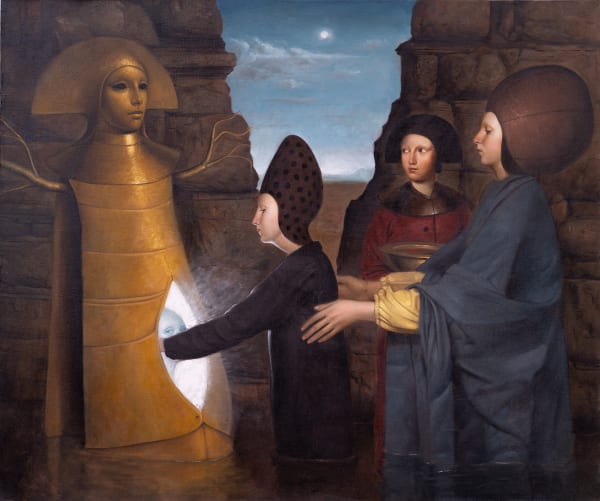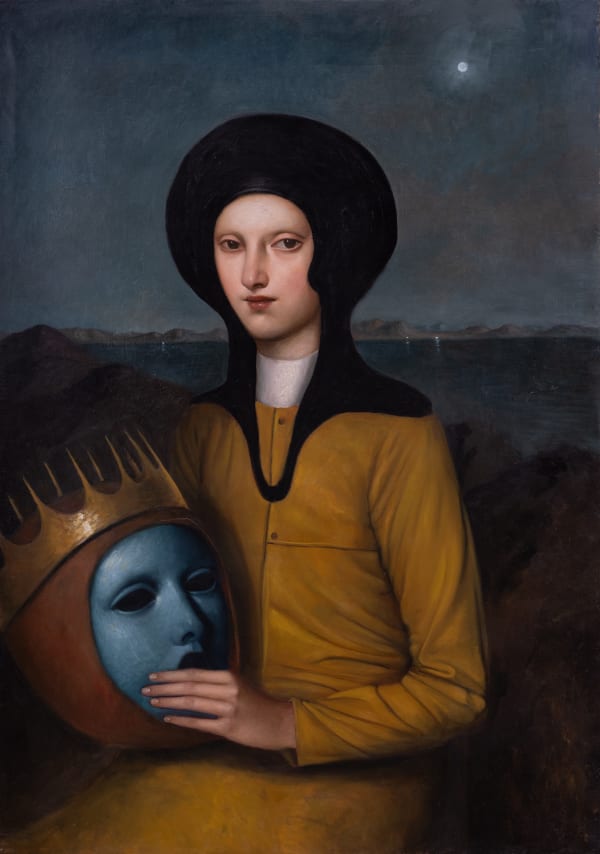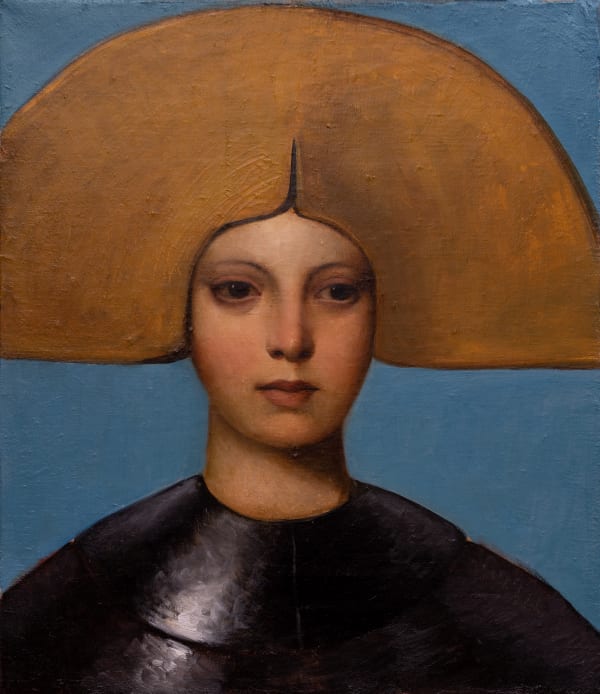Primo Marella Gallery Lugano is pleased to present for the first at time at Lugano the solo show by the Italian artist Alessandro Sicioldr.
Gospel of Luke, verse 1:28: The angel entering her said, "I greet you, O full of grace, the Lord is with you." She is evidently Mary. It is the moment of the announcement. Everything revolves around that expression "the Lord is with you," and it takes on an unexpected dimension. We are not confronted with a simple conventional and beneaguring formula but with the signaling of a specific fact: the Lord, that is, God, that is, the Other, has settled in the girl's body. The "with" is not preposition of a companion complement, but with more radicality announces a proximity, a being body within another body. The sacred had manifested itself in the most unexpected way, without an aura, without special effects, disarmed in the size of a child.For centuries for painters the translation into images of this pivotal episode in Christian history was a professional task. As Michael Baxandall has written, "What we easily forget today is that every devout person happened to perform the same task occasionally...to conceive visually the episodes in the lives of Christ and Mary...The painter's visualizations were exterior, the audience's interior." This is how it worked for centuries, until modernity's acceleration of the secularization process and the gradual oblivion of that imagery. Today the artist has come to lack that ideally shared background in which the visions he proposed found a correspondence in those elaborated by faith by those who were his recipients. To stay with the categories indicated by Baxandall, if the exterior visualizations seem to have exhausted themselves for historical reasons, the interior ones, on the other hand, continue to flourish and to fulfill, outside of all dogma, an essential need of the human being: the need to establish a relationship with the sacred, to be able to have a tangible and visible experience of it. Thus the modern artist has only been left to converge with his craft and sensibility on the terrain of these free inner visualizations.
Faithful to his vocation as a painter, Alessandro Sicioldr wanted to break the hesitations and face the challenge, on the occasion of this Lugano exhibition. In fact, with his work he has always measured himself with great intensity with the dimension of mystery, letting this dimension always remain circumfused, marked by an allusiveness open to many possible interpretations. With the title given for the exhibition, "The Dream of an Announcement," Sicioldr immediately highlights the desire to relate to the factors of that story triggered by Luke's verse. With a profound difference: we are no longer faced with an announcement as an incidental fact, but with a "dream." "Dream" can be interpreted in a double meaning: it can indicate a desire, a wish that an "announcement" will happen and restore visibility to the sacred on the scene of history. But dream is also synonymous with "unrealizable thing," and in this case the "announcement" would be relegated to the sphere of the dreamlike. "The common thread of all my works is precisely annunciation," the artist notes, "that is, the clumsy attempt of a modern, rational mind to get in touch with the dimension of the sacred. All the paintings are basically the same painting and speak of this."
He is very sincere Alexander in this reflection. He acknowledges that rationality relates very awkwardly to themes of the sacred, and yet those themes, even for a modern and therefore "rational" artist like him, remain the substance of painting. How to overcome that dichotomy? I try to put forward a possible answer: Sicioldr manages to hold these two conflicting polarities together through the clarity of his pictorial language. It is first of all the formal clarity with which he constructs and organizes his paintings, as in the case of Solstice d'inverno, the large canvas presented in December 2022 at the Classense Library in Ravenna. But it is also a mental clarity thanks to which he manages to govern his subjects, each time constructing visual storytelling, the solution of which necessarily remains undecipherable, but which presents itself to our eyes with great clarity and without ambiguity. Among the works that most directly relate to the theme of announcement is Chrysalis. Sicioldr memorializes that preposition "with" in Luke's verse, and gives us an image of consistency that is as mysterious as it is also physical. The group of women reaching out toward the belly of the priestess-totem, pregnant with a luminous body, echoes the ancient iconography of the Visitation, which in the chronology of the Gospels follows the Annunciation: the two central figures bound together are both stretched in the direction of this sacred face.
In his compositional devices, Sicioldr always introduces an element that breaks the self-referentiality of the subjects and opens a relationship with the viewer of the work: curiously, in this canvas the task is assigned precisely to the sacred face, which, with a biased eye, turns its gaze toward us, almost shunning its direct interlocutor. In this way, the timelessness that seals Sicioldr's compositions enters each time in connection with our time, that is, with the passing of time. It is an exchange that is established thanks to the fact that the artist conceives the space of the canvas as a theatrical space, complete with recurring sign symbols, such as curtains or masks. The horizon, as in theater, is that of fiction, but fiction is nothing more than an alienating way of interlocuting with the listener, of depositing in his ear and eyes the content of an announcement. Announcement as the title of a small canvas in which the subjects are reduced to their essentials. One can see a large golden mask peeking out, not surprisingly, from behind a curtain is communicating its message, and there is a female figure so immersed in what she is hearing that she becomes ontologically one with the content of the message. The mechanism of fiction is what clears the space for a revelation to occur....
There can be little doubt that Sicioldr's imagery draws from the ever-fertile root of surrealism: some of Leonora Carrington's works seen at the last Venice Biennale anticipate the taste for the magical, the esoteric and the vitalistic on which the Tuscania-based artist feeds. However, his way of approaching those mental territories in which imagination and psychic projections have free rein is always governed by a discipline that has little to do with the creative automatisms proper to surrealism. His works of this new season are further confirmation of this. They can also be read as excavations into the unconscious, but perhaps the real key to reading them is another: Sicioldr has been and is at every moment under the spell of the infinite world of mystery, and with the skill and constancy of a neo-fourteenth-century master he tries each time to translate it into a visual narrative. Translating it does not at all mean explaining it; if anything, it means holding its fascination, transmitting its attraction, and above all respecting its order no matter how indecipherable it appears.
Critic text curated by Giuseppe Frangi
























